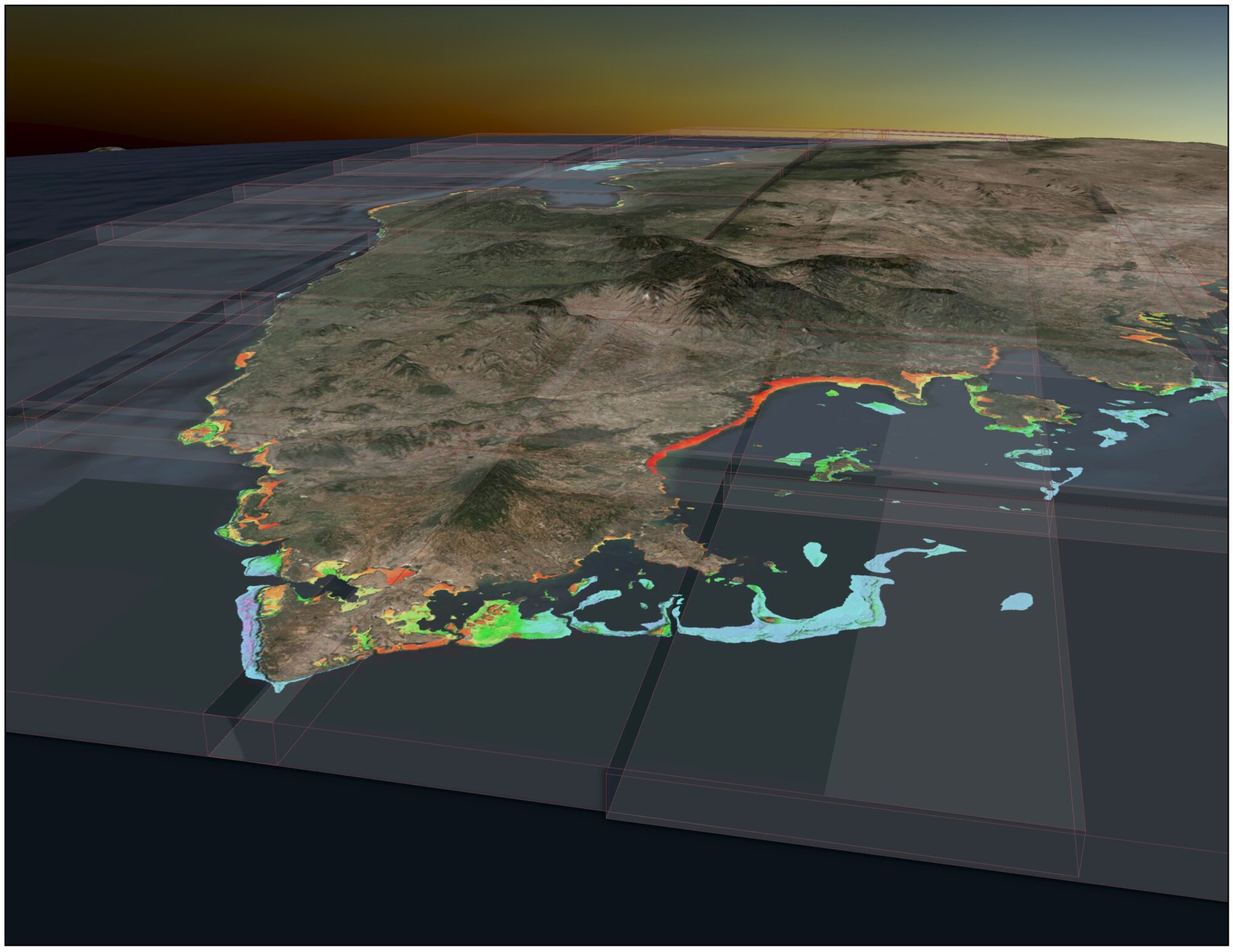Denver, Colorado, 2 November 2023 – TCarta Marine, a global provider of hydrospatial products and services, has delivered three major satellite derived bathymetry (SDB) data sets to The Nippon Foundation-GEBCO Seabed 2030 project. Students in Canada participating in a 2023 summer internship program created the SDB products for the entire coastline of Madagascar, Newfoundland, and two Canadian Arctic research areas.

The Madagascar SDB delivered to Seabed 2030, shown looking south over Nosy Hara Archipelago Marine National Park, produced from Sentinel-2 composites.
TCarta co-sponsored the first-of-its-kind SDB Internship in cooperation with Seabed 2030 and the Marine Institute (MI) of Memorial University in Newfoundland, Canada. Held at the MI Ocean Mapping facility in St. John’s, the program instructed six undergraduate and two graduate hydrography students in the use of SDB processes, satellite Earth observation platforms, advanced sensor systems, and artificial intelligence for seafloor mapping.
“As is true of most Seabed 2030 data sets, these bathymetry products will be applied in local projects as well as the global program,” said Kyle Goodrich, TCarta President. “The Canadian Arctic data, for example, will be used in fisheries research conducted by the Marine Institute.”
Goodrich will present details of the summer 2023 project at the Map the Gap Symposium being held Nov. 7-8 in Monaco.
Launched by The Nippon Foundation of Japan and the General Bathymetric Chart of the Oceans (GEBCO) program, Seabed 2030 seeks to inspire the complete mapping of the entire ocean floor by the end of the decade. A flagship program of the UN Ocean Decade, the data will be publicly available and will support coastal resilience, environmental protection, and other marine applications.
“This collaborative internship co-sponsored with our partners Memorial University and TCarta has enabled students to acquire cutting edge hydrospatial skill sets,” commented Seabed 2030 Project Director Jamie McMichael-Phillips. “The SDB data sets provided by students of the summer internship will be instrumental in supporting the global effort underway to deliver a complete map of the ocean floor by 2030.”
The student internship program is one facet of TCarta’s international capacity building initiative that seeks to instruct hydrographers worldwide in the production of SDB data for their coastlines. Training focuses on the use of TCarta’s Trident SDB Toolbox, a series of software applications running within Esri ArcGIS Pro to extract water depth measurements from remotely sensed imagery with Machine Learning and satellite LiDAR.
Processing government and commercial multispectral satellite imagery, the 2023 summer interns generated 10-meter resolution SDB data to depths of 25 meters along the Madagascar coast and 20 meters in Newfoundland, and seven to eight meters in the Canadian Arctic locations. NASA ICESat-2 LiDAR data was used for validation, a new technique developed by TCarta.
Coastal Madagascar was a challenge due to its geographic size and shallow water turbidity, while the murky Arctic waters were difficult due to several factors, including the scarcity of ice-free satellite images. In recent years, TCarta has significantly enhanced the utility of SDB technology in turbid, murky water conditions leveraging grants from the National Science Foundation (NSF) and National Oceanic & Atmospheric Administration (NOAA).
The two Canadian Arctic SDB data sets will also be used in Memorial University marine research activities.
“SDB is a natural fit with the in-situ soundings collected through the Qikiqtaaluk Fisheries Corporation’s Community Hydrography project and delivered through TCarta and the Marine Institute, focused on the community’s priorities and local knowledge of on-water access to their traditional hunting and fishing areas in the Qikiqtani region of Nunavut,” said Kirk Regular, Marine Geomatics Researcher at the Centre for Applied Ocean Technology at Memorial University.
About TCarta
With offices in the United States, Jamaica, and Canada, TCarta has built an international business on cost-effectively and safely deriving onshore and offshore data sets using multispectral imagery captured by Earth observation satellites – without negative impact on the natural habitat. TCarta products and services are relied upon by governmental, insurance, oil & gas, environmental, and infrastructure development clients in applications as diverse as natural resource monitoring, tsunami modeling, disaster & hazard response, and hydrologic studies. The TCarta product lines include high-resolution satellite-derived water depth and seafloor map products as well as 90- and 30-meter GIS-ready bathymetric data aggregated from numerous information sources. TCarta has also recently unveiled the use of ICESat-2 LiDAR data sets for use in SDB validation, and the TCarta Global Satellite Derived Bathymetry (G-SDB) off-the-shelf products. G-SDB is generated with Machine Learning and ICESat-2 laser data at 10m resolution to depths of 30m depending on water clarity. www.tcarta.com